In the User operation log window, you can search and browse logs by user. This section describes how to browse logs in the User operation log window.
The procedure is as follows:
Start the Log Viewer and click Display items settings.
The Display items settings window is displayed.
Select Log Viewing Database as the database for browsing operation logs.
Refer to "Change the database to be viewed" for details on operation.
In the menu, click User operation log.
The User operation log window is displayed.
In Select Section, select the search target groups.
In Range of display > Sub-level contained, select whether to display all users or just the users directly under the selected group.
Selecting Root directory searches for all users.
Selecting a group searches for all users in that group.
If a log for a user who is not registered in the user policy has been recorded, the user name retrieved from that log is displayed as a user in the Other users group.
List of searched users displays a list of the users who belong to the selected group.
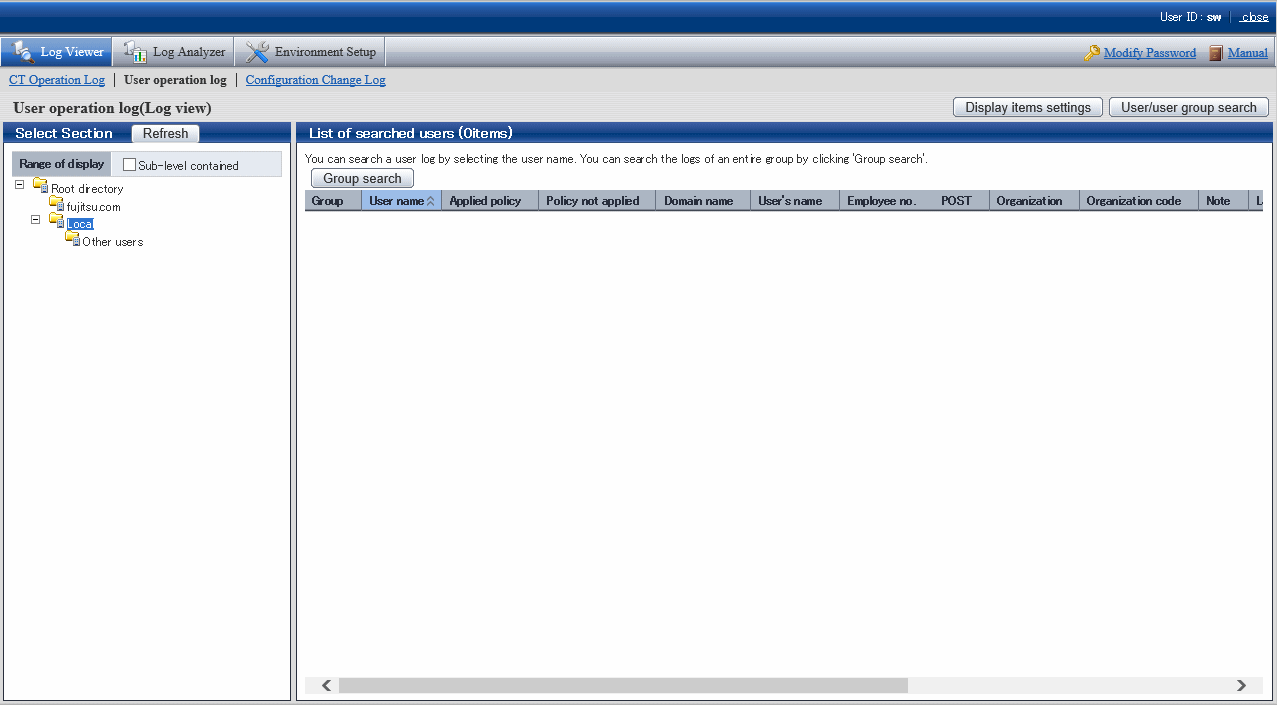
The following table describes the items that are displayed in List of searched users:
Item name | Description |
|---|---|
Group | This is the name of the group to which the user belongs. |
User name | This is the user name entered at logon. |
Applied policy | This is the applied policy.
Nothing is displayed for users in the Other users group. |
Policy not applied | If the settings are configured not to apply a policy, Do not apply is displayed. |
Domain name | If the user has been registered in the user policy and was created through linkage with Active Directory, the domain address registered in the Active Directory linkage settings of the Server Settings Tool is displayed. If the user has been registered in the user policy and is in Local group, Local is displayed. If the user is in the Other users group, Local is displayed. |
User's name | The value set in the User Policy Settings window of the Management Console is displayed. |
Employee no. | The value set in the User Policy Settings window of Management Console is displayed. |
POST | The value set in the User Policy Settings window of Management Console is displayed. |
Organization | The value set in the User Policy Settings window of Management Console is displayed. |
Organization code | The value set in the User Policy Settings window of Management Console is displayed. |
Note | The value set in the User Policy Settings window of Management Console is displayed. |
Last policy acquisition date and time | This is the date and time at which the latest policy was set. |
Server (DB) update date and time | This is the final date and time at which the Management Server or Master Management Server updated the client (CT) and smart device (agent) policy and updated it in the database (including immediate update). |
Registration datetime | This is the date and time at which the user was registered. |
Point
To change the items displayed in List of searched users, display the Display items settings window by clicking Display items settings, and then change the items in Display settings for list of searched users.
The procedure is the same as that for Display settings for list of searched CTs. Refer to "Set visible columns in [List of searched CT]" for details.
Perform one of the following operations according to the purpose of browsing the user operation logs:
Browse logs by user
In List of searched users, click User name of the user whose logs you want to browse.
Browse the logs of users in the range selected in the group tree
In List of searched users, click Group search.
The User operation log(Log view) - Log search window is displayed.
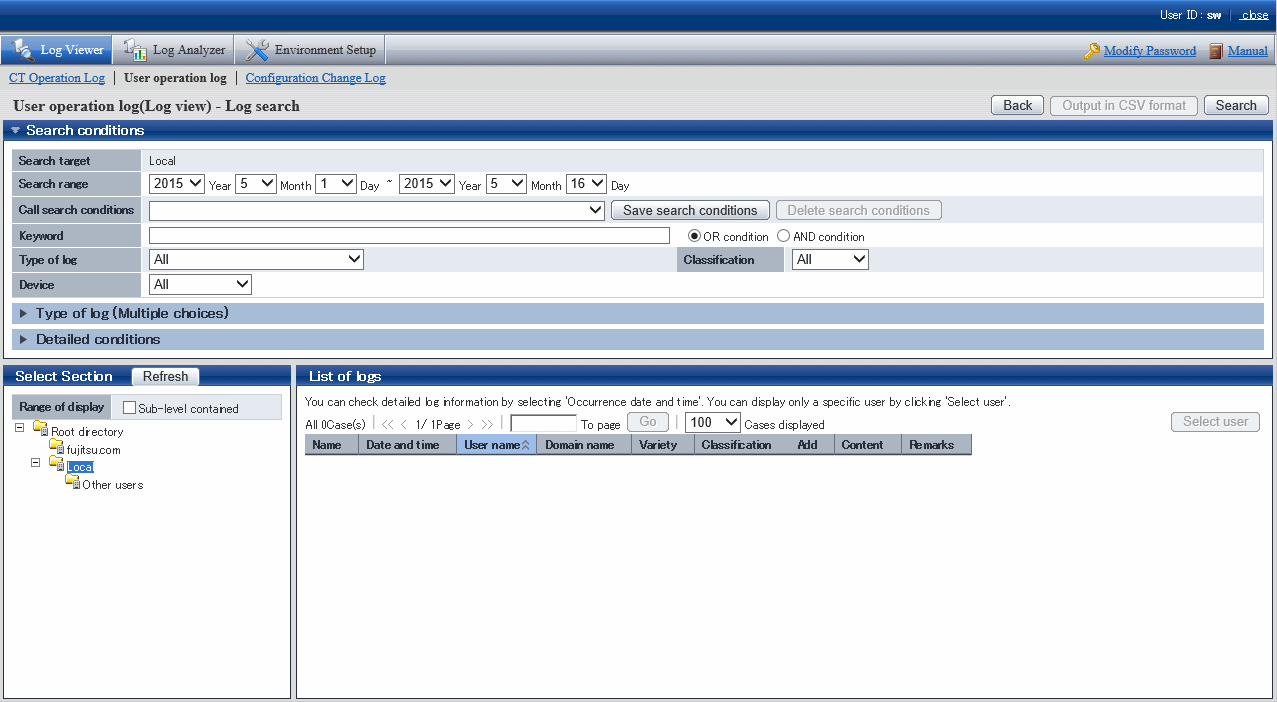
You can open and close the Search conditions, Type of log (Multiple choices), and Detailed conditions panes.
Clicking User operation log(Log view) - Log search, Type of log (Multiple choices), or Detailed conditions (the expand icon) opens the search conditions.
Clicking User operation log(Log view) - Log search, Type of log (Multiple choices), or Detailed conditions closes the search condition pane.
Set User operation log(Log view) - Log search.
To set detailed conditions such as the drive type and log collection time, click Detailed conditions.
Item name | Description |
|---|---|
Search target | The selected search target is displayed. |
Search range | Searches a specified time range. If you do not specify the start time and end time of Search range, all search periods may be searched.
If you do not specify any end month or date, the search will end at the end of the specified year (December 31).
If you omit the year, you must omit the month and day. The date on which you display the User operation log(Log view) - Log search window is displayed as the initial value for both the start date and end date. |
Call search conditions | Invokes saved search conditions. The methods for saving or deleting search conditions are as follows:
|
Keyword | Searches according to log keyword. When specifying multiple keywords, enter a halfwidth or fullwidth space between keywords. |
Type of log | Searches a selected log type. |
Classification | You can select allowed operations or unallowed operations in the policy settings. To search allowed operations, select Normal. To search unallowed operations, select Violation. Selecting All is equivalent to selecting Normal and Violation. |
Device | Searches according to the selected device type. To search only client (CT) logs, select PC. To search only smart device (agent) logs, select Smart device. Selecting All sets PC and Smart device, and all device logs will be searched. |
Type of log (Multiple choices)
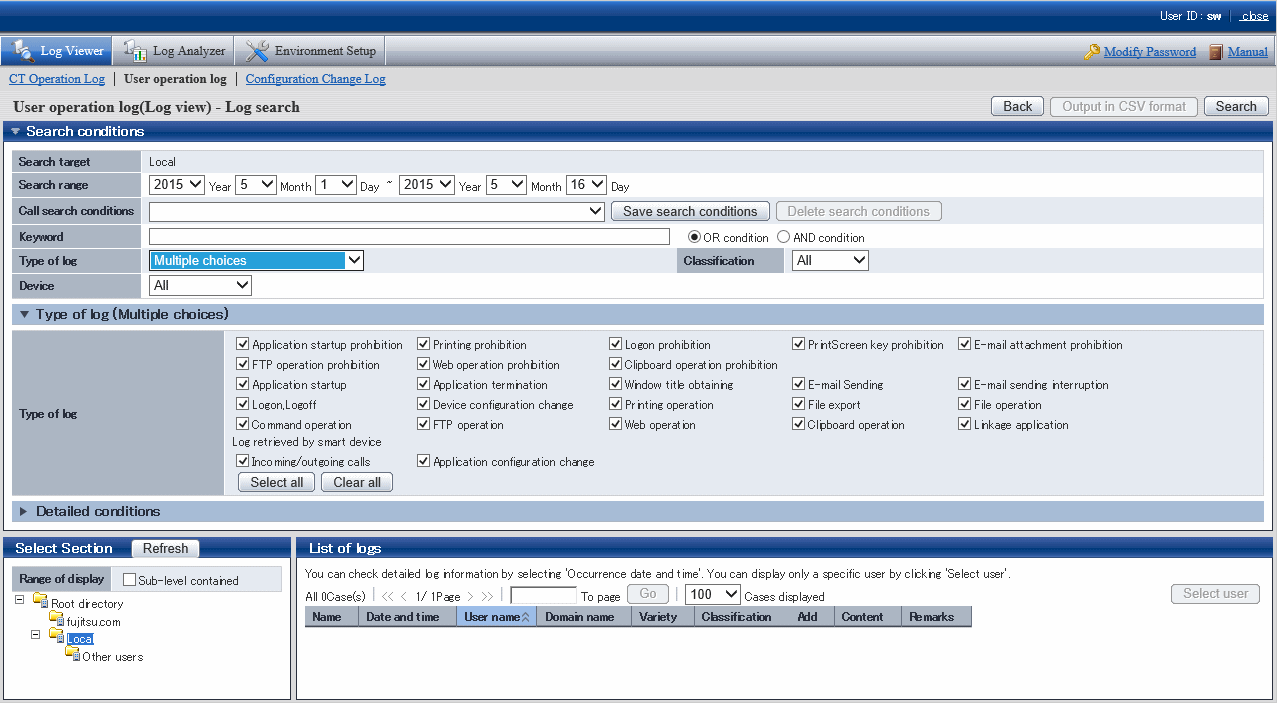
Item name | Description |
|---|---|
Type of log | Select the types of log to be displayed in List of logs. Refer to "Types of log that can be viewed" for details on log types. Select all: Selects all log types. |
Detailed conditions
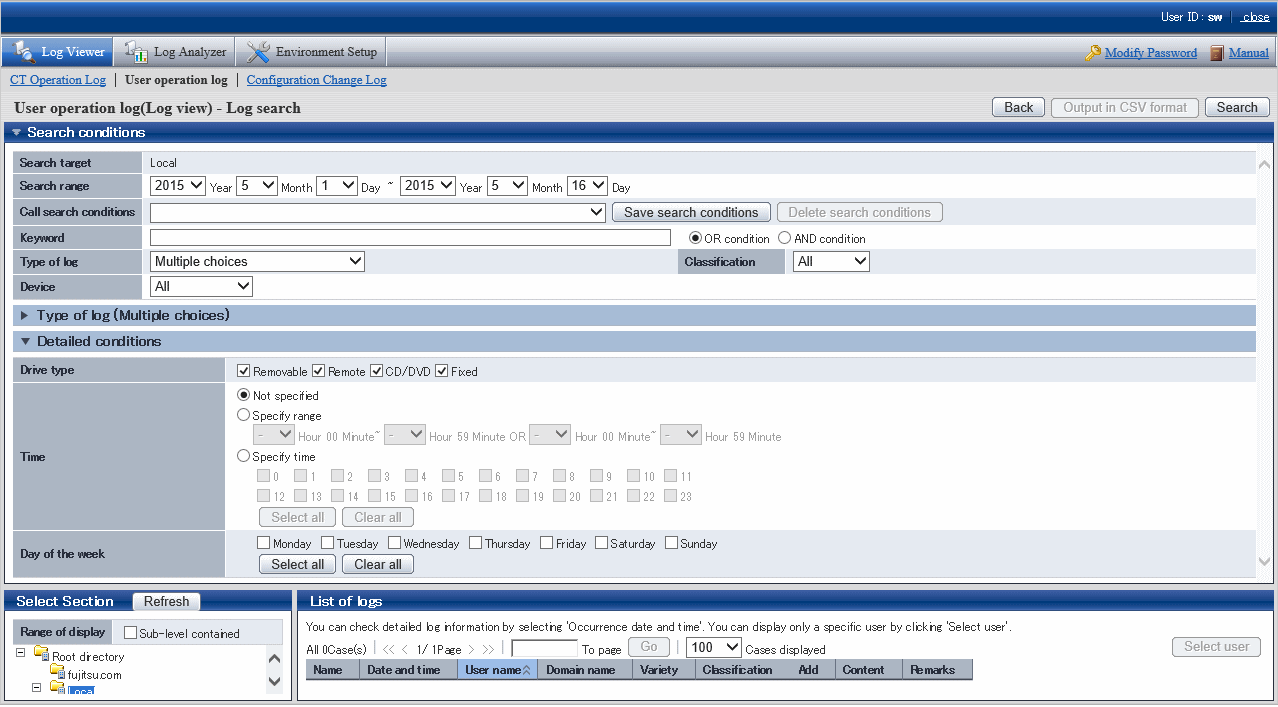
Item name | Description |
|---|---|
Drive type | Searches according to drive type.
The following drive types can be specified - specify one or more:
Relationship between searched logs and the settings for Type of log and Drive type
|
Time |
If you specify Day of the week together with this condition, the search will be an AND search using all conditions. |
Day of the week | Select all: Selects all check boxes in Day of the week. Clear all: Clears all check boxes in Day of the week. Day of the week check box: To specify the day of the week on which a log was collected as a search condition, select the desired day of the week. If you select multiple days of the week, the search will be an OR search using at least one day of the week. If you do not select any day of the week, all days of the week are assumed to have been selected. If you specify Time together with this condition, the search will be an AND search using all conditions. |
Click Search.
Note
If you specify a large number of users or a long search period in the search conditions, the following message may be displayed:
[LWSV-SEL003] A search may not be possible due to the large amount of data targeted for search. Continue processing?
If the conditions do not need to be reviewed, continue processing.
If the search takes a long time, a timeout may occur. Alternatively, if there is a large number of search results, the search may be canceled and one of the following messages may be displayed:
[LVSY-ERR015] Processing will be canceled because the number of log items will exceed %d. Review the conditions.
[LWSV-ERR011] Processing will be canceled because the number of log data items (%d) was exceeded. Review the conditions.
In this case, refine the search conditions before performing the search again.
Examples of refining search conditions:
Reducing the search time
Reducing the number of users set as the search target
Setting a search keyword
The search results are displayed in List of logs.
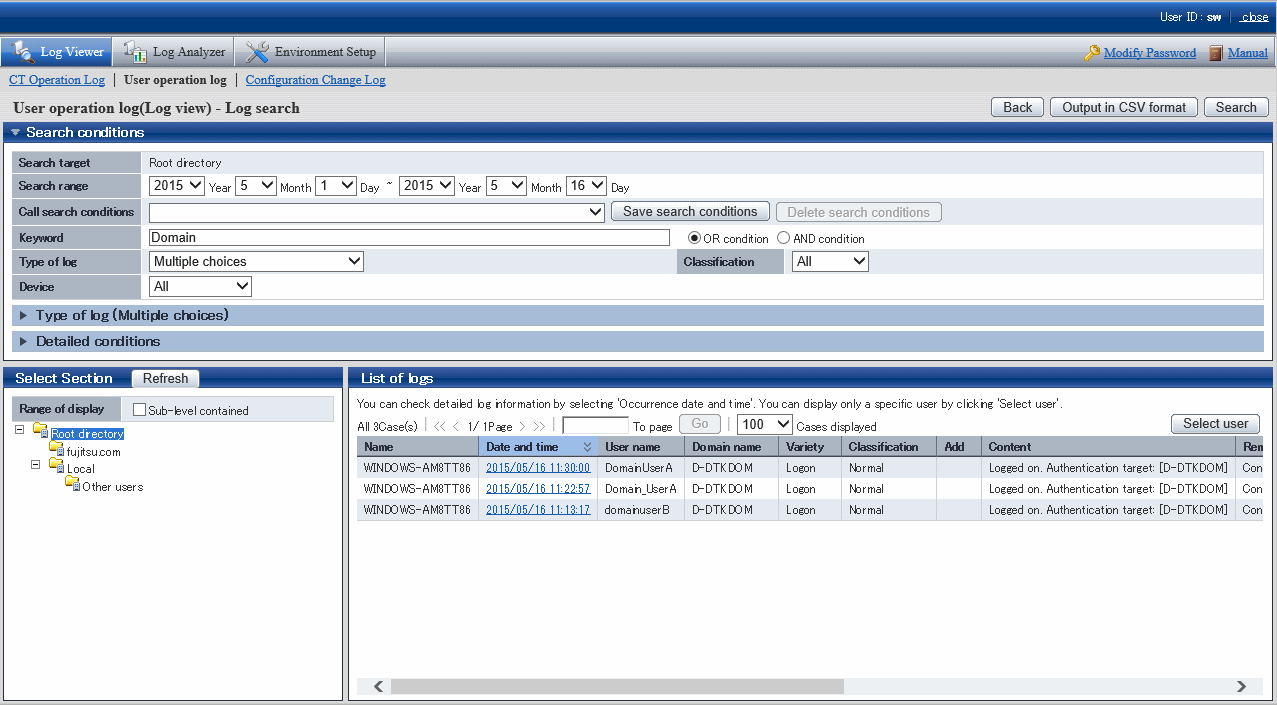
The search results data that is displayed in List of logs is arranged in ascending user name order and ascending date and time.
To view logs by client (CT), click Name to sort them.
You can view a list of logs of a particular user by clicking Select user and selecting the user. Alternatively, you can view a list of logs of all users.
The content that is displayed in List of logs and the procedure for operating it are the same as those for List of logs in the CT Operating Log window. Refer to "5.2.1 View Logs in the CT Operation Log Window" for details.